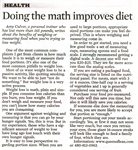 Doing the math improves diet Doing the math improves diet
One of the most common complaints I get from clients is how much hassle it is to weigh or measure their food portions. It's also one of the most common pitfalls to weight loss.
Most of us want weight loss to be a passive activity, like quitting smoking. We want to be able to just “not do something.” But weight loss is a very active process.
Weight loss is math, plain and simple. If you consume less calories than you burn, you lose weight. If you don't weigh and measure your food, you can’t know how many calories you are consuming.
One argument against weighing and measuring is that you can go by your hunger signals. Yes, this is true. But in my experience, those who have a significant amount of weight to lose have long ago lost touch with their own hunger signals.
It is easy to lose perspective regarding portion sizes. When you are used to large portions, appropriate sized portions can make you feel deprived. This is where weighing and measuring come in.
In order to get started, you need a few good tools: a set of measuring cups, measuring spoons and a food scale. I strongly recommend getting a digital scale. A decent one will run you $20-25. They are far more accurate than the analog scales.
If you are eating a packaged food, the serving size is listed on the nutritional panel. For meats, start with 3 or 4 ounces. One-half cup is a serving of vegetables and 1 cup is generally considered one serving of fruit.
Purchase your food pre-measured. Not only will this save you time, but also it will likely save you calories.
If someone else does the measuring for you, you are more likely to accept that portion as “enough.”
Start portioning out your meals accordingly. Yes, at first it may not seem like very much, but once you re-train your eyes, those giant 16-ounce steaks will look like enough to feed a family of four, which they are!
Until next time, stay healthy and be happy.
|

